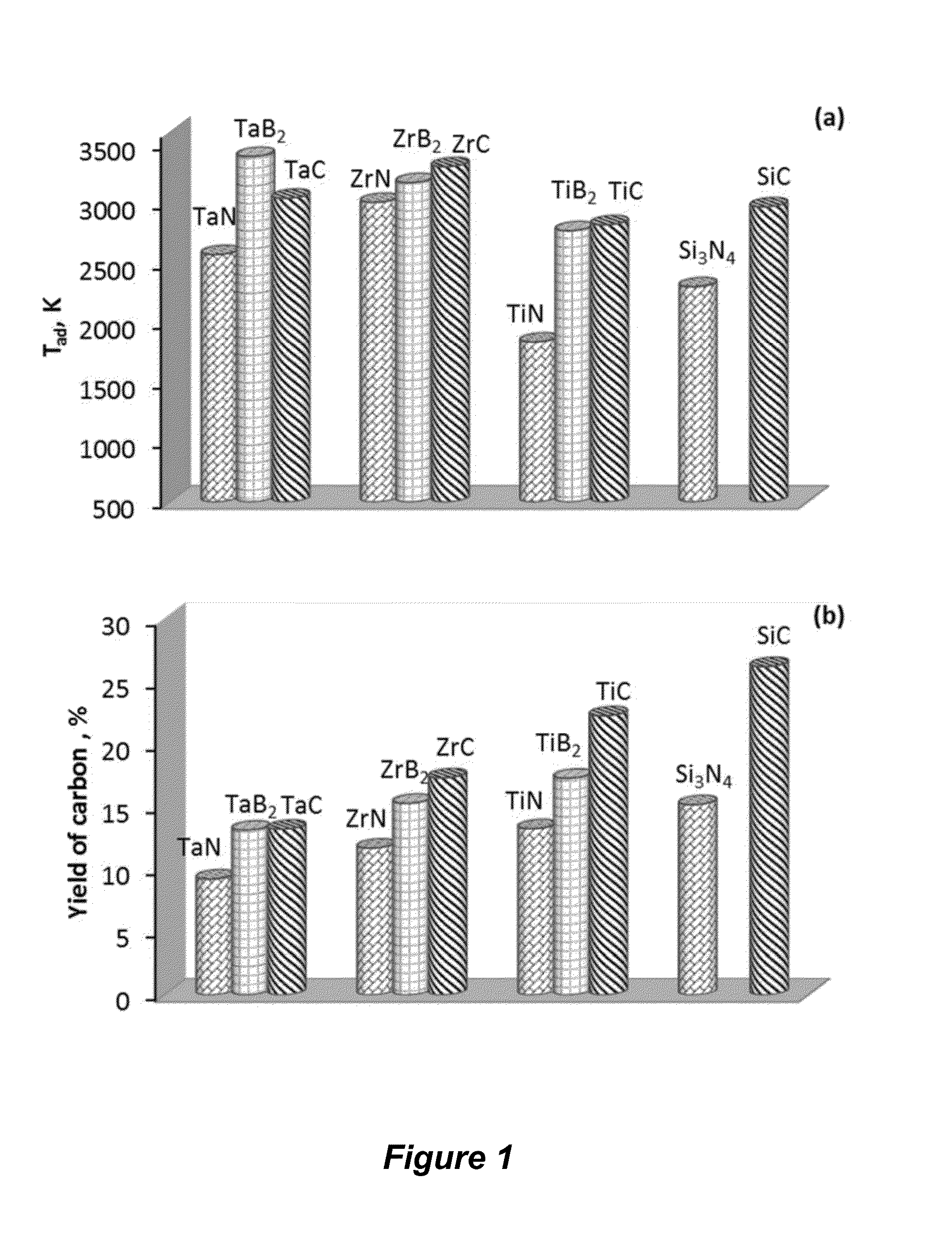Combustion synthesis of graphene and carbonous nanomaterials
a carbon nanomaterial and combustion synthesis technology, applied in the field of combustion synthesis of graphene and carbon nanomaterials, can solve the problems of affecting the application performance of graphene, reducing the electronic properties of graphene, and unable to remove many irreversible lattice defects, so as to facilitate a higher ratio of graphene sheet products, reduce reaction temperature, and increase surface area
- Summary
- Abstract
- Description
- Claims
- Application Information
AI Technical Summary
Benefits of technology
Problems solved by technology
Method used
Image
Examples
example 1
Synthesis of Carbon-Based Nano-Structures
[0086]Thermodynamic Calculations. Thermodynamic calculations for reactions between PTFE and refractory materials such as carbides (TaC, ZrC, TiC, SiC), nitrides (TaN, ZrN, TiN), as well as borides (TaB2, ZrB2, TiB2) were performed using THERMO software (Shiryaev, Int. J. SHS 1995; 4:351-362). The adiabatic combustion temperature (Tad) and equilibrium products were calculated as a function of the initial mixture composition, which can also include sodium chloride or a similar non-reactive salt, and inert gas (e.g., argon) pressure in the chemical reactor. Based on the thermodynamic calculations the systems were selected for the further experimental studies.
[0087]Synthesis. Combustion synthesis (CS) experiments were performed under optimal parameters determined by thermodynamic calculation. In a typical experiment, ceramic powders (i.e., SiC or TiN) with the particle size being less than about 45 μm and polytetrafluoroethylene (particle size 3-...
example 2
General Process to Prepare and Isolate Graphene Materials
[0096]Step A. Preparation of the initial reaction mixture. Desired amounts of ceramic and polymer powders (typically a ratio of about 2:1 to about 1:5 of ceramics:polymer) in the form of fine powders (approximately 0.5-10 μm particle size) are thoroughly mixed for several hours. For example, an effective molar ratio of ceramic:polymer in the SiC+polytetrafluoroethylene system is 1:0.75. In addition to reactants, some amount of sodium chloride (about 20 wt. % to about 70 wt. % of initial mixture) is added to the reactant to control the combustion temperature of the process. The salt is an inert additive, which decreases the reaction temperature and can be easily removed from solid product by washing the products. Prior to mixing, the components can be dried at approximately 100° C. for several hours and then weighed to appropriate amounts. Mixing of the reactants may be performed by any suitable and effective method, such as a ...
example 3
Combustion Synthesis of Graphene and Carbonous Particles
[0100]Step A. Preparation of the initial reaction mixture. A mixture of 8.5 grams of silicon carbide (Alfa Aesar, average particle size ˜5 μm) and 25 gram of sodium chloride (Alfa Aesar, particle size ˜50 μm) was milled in a stabilized zirconium oxide jar for 30 minutes. Zirconium oxide balls (5 mm in diameter) were used in the milling process. The ball to powder mass ratio was 5:1. The milling speed was 650 rpm. Afterward, the milling jar was opened and 17.5 grams of PTFE powder was added followed by additional mixing with rotation speed of 100 rpm for 1.5 hours.
[0101]Step B. Combustion Synthesis. The as-prepared reactive mixture was separated from the milling balls by sieving and were loaded into a ceramic boat, which was then transferred to a high pressure reaction chamber (volume of 5 litters). A tungsten wire was positioned about 5 mm inside the reaction mixture. The chamber was sealed, evacuated, and purged with an inert ...
PUM
| Property | Measurement | Unit |
|---|---|---|
| length | aaaaa | aaaaa |
| length | aaaaa | aaaaa |
| width | aaaaa | aaaaa |
Abstract
Description
Claims
Application Information
 Login to View More
Login to View More - R&D
- Intellectual Property
- Life Sciences
- Materials
- Tech Scout
- Unparalleled Data Quality
- Higher Quality Content
- 60% Fewer Hallucinations
Browse by: Latest US Patents, China's latest patents, Technical Efficacy Thesaurus, Application Domain, Technology Topic, Popular Technical Reports.
© 2025 PatSnap. All rights reserved.Legal|Privacy policy|Modern Slavery Act Transparency Statement|Sitemap|About US| Contact US: help@patsnap.com



